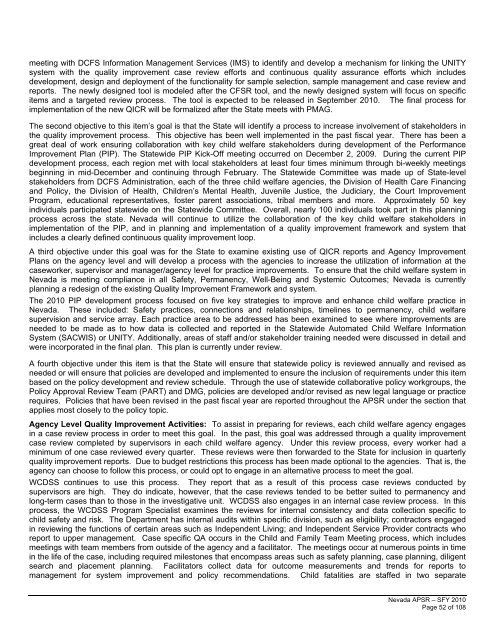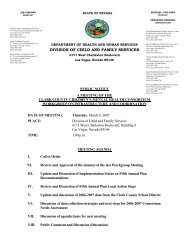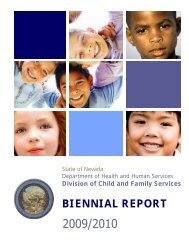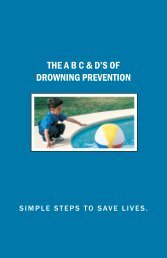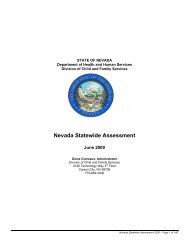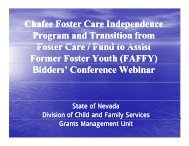STATE OF NEVADA - Division of Child and Family Services
STATE OF NEVADA - Division of Child and Family Services
STATE OF NEVADA - Division of Child and Family Services
You also want an ePaper? Increase the reach of your titles
YUMPU automatically turns print PDFs into web optimized ePapers that Google loves.
meeting with DCFS Information Management <strong>Services</strong> (IMS) to identify <strong>and</strong> develop a mechanism for linking the UNITY<br />
system with the quality improvement case review efforts <strong>and</strong> continuous quality assurance efforts which includes<br />
development, design <strong>and</strong> deployment <strong>of</strong> the functionality for sample selection, sample management <strong>and</strong> case review <strong>and</strong><br />
reports. The newly designed tool is modeled after the CFSR tool, <strong>and</strong> the newly designed system will focus on specific<br />
items <strong>and</strong> a targeted review process. The tool is expected to be released in September 2010. The final process for<br />
implementation <strong>of</strong> the new QICR will be formalized after the State meets with PMAG.<br />
The second objective to this item’s goal is that the State will identify a process to increase involvement <strong>of</strong> stakeholders in<br />
the quality improvement process. This objective has been well implemented in the past fiscal year. There has been a<br />
great deal <strong>of</strong> work ensuring collaboration with key child welfare stakeholders during development <strong>of</strong> the Performance<br />
Improvement Plan (PIP). The Statewide PIP Kick-Off meeting occurred on December 2, 2009. During the current PIP<br />
development process, each region met with local stakeholders at least four times minimum through bi-weekly meetings<br />
beginning in mid-December <strong>and</strong> continuing through February. The Statewide Committee was made up <strong>of</strong> State-level<br />
stakeholders from DCFS Administration, each <strong>of</strong> the three child welfare agencies, the <strong>Division</strong> <strong>of</strong> Health Care Financing<br />
<strong>and</strong> Policy, the <strong>Division</strong> <strong>of</strong> Health, <strong>Child</strong>ren’s Mental Health, Juvenile Justice, the Judiciary, the Court Improvement<br />
Program, educational representatives, foster parent associations, tribal members <strong>and</strong> more. Approximately 50 key<br />
individuals participated statewide on the Statewide Committee. Overall, nearly 100 individuals took part in this planning<br />
process across the state. Nevada will continue to utilize the collaboration <strong>of</strong> the key child welfare stakeholders in<br />
implementation <strong>of</strong> the PIP, <strong>and</strong> in planning <strong>and</strong> implementation <strong>of</strong> a quality improvement framework <strong>and</strong> system that<br />
includes a clearly defined continuous quality improvement loop.<br />
A third objective under this goal was for the State to examine existing use <strong>of</strong> QICR reports <strong>and</strong> Agency Improvement<br />
Plans on the agency level <strong>and</strong> will develop a process with the agencies to increase the utilization <strong>of</strong> information at the<br />
caseworker, supervisor <strong>and</strong> manager/agency level for practice improvements. To ensure that the child welfare system in<br />
Nevada is meeting compliance in all Safety, Permanency, Well-Being <strong>and</strong> Systemic Outcomes; Nevada is currently<br />
planning a redesign <strong>of</strong> the existing Quality Improvement Framework <strong>and</strong> system.<br />
The 2010 PIP development process focused on five key strategies to improve <strong>and</strong> enhance child welfare practice in<br />
Nevada. These included: Safety practices, connections <strong>and</strong> relationships, timelines to permanency, child welfare<br />
supervision <strong>and</strong> service array. Each practice area to be addressed has been examined to see where improvements are<br />
needed to be made as to how data is collected <strong>and</strong> reported in the Statewide Automated <strong>Child</strong> Welfare Information<br />
System (SACWIS) or UNITY. Additionally, areas <strong>of</strong> staff <strong>and</strong>/or stakeholder training needed were discussed in detail <strong>and</strong><br />
were incorporated in the final plan. This plan is currently under review.<br />
A fourth objective under this item is that the State will ensure that statewide policy is reviewed annually <strong>and</strong> revised as<br />
needed or will ensure that policies are developed <strong>and</strong> implemented to ensure the inclusion <strong>of</strong> requirements under this item<br />
based on the policy development <strong>and</strong> review schedule. Through the use <strong>of</strong> statewide collaborative policy workgroups, the<br />
Policy Approval Review Team (PART) <strong>and</strong> DMG, policies are developed <strong>and</strong>/or revised as new legal language or practice<br />
requires. Policies that have been revised in the past fiscal year are reported throughout the APSR under the section that<br />
applies most closely to the policy topic.<br />
Agency Level Quality Improvement Activities: To assist in preparing for reviews, each child welfare agency engages<br />
in a case review process in order to meet this goal. In the past, this goal was addressed through a quality improvement<br />
case review completed by supervisors in each child welfare agency. Under this review process, every worker had a<br />
minimum <strong>of</strong> one case reviewed every quarter. These reviews were then forwarded to the State for inclusion in quarterly<br />
quality improvement reports. Due to budget restrictions this process has been made optional to the agencies. That is, the<br />
agency can choose to follow this process, or could opt to engage in an alternative process to meet the goal.<br />
WCDSS continues to use this process. They report that as a result <strong>of</strong> this process case reviews conducted by<br />
supervisors are high. They do indicate, however, that the case reviews tended to be better suited to permanency <strong>and</strong><br />
long-term cases than to those in the investigative unit. WCDSS also engages in an internal case review process. In this<br />
process, the WCDSS Program Specialist examines the reviews for internal consistency <strong>and</strong> data collection specific to<br />
child safety <strong>and</strong> risk. The Department has internal audits within specific division, such as eligibility; contractors engaged<br />
in reviewing the functions <strong>of</strong> certain areas such as Independent Living; <strong>and</strong> Independent Service Provider contracts who<br />
report to upper management. Case specific QA occurs in the <strong>Child</strong> <strong>and</strong> <strong>Family</strong> Team Meeting process, which includes<br />
meetings with team members from outside <strong>of</strong> the agency <strong>and</strong> a facilitator. The meetings occur at numerous points in time<br />
in the life <strong>of</strong> the case, including required milestones that encompass areas such as safety planning, case planning, diligent<br />
search <strong>and</strong> placement planning. Facilitators collect data for outcome measurements <strong>and</strong> trends for reports to<br />
management for system improvement <strong>and</strong> policy recommendations. <strong>Child</strong> fatalities are staffed in two separate<br />
Nevada APSR – SFY 2010<br />
Page 52 <strong>of</strong> 108


